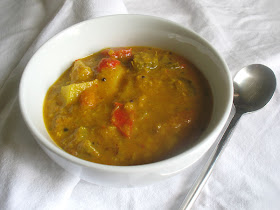Spicy sambars are generally the first course of traditional South Indian meals, followed up by brothy and lighter rasams and other vegetable dishes, such as poriyals. These thick soup-like creations can be made up of pretty much any vegetables you have on hand and are typically served with rice and other accompaniments. A typical base for sambars is tamarind, dal and yogurt. They are substantial enough to serve as the main course of the meal, as I did with this one with some rice on the side and some Indian flat breads.
Here, an easy paste is prepared for inclusion, and the base is one of toor dal and tamarind, with eggplant, pepper, potato and drumstick as the starring vegetables. I think this must be my first time cooking with drumstick. It is easily found at Asian and Indian grocery stores. Long and skinny, it is somewhat squash like and a popular addition to curries, dal dishes and soups. It comes from the Moringa tree. In addition to the immature seed pods, which are known as the drumsticks themselves, the leaves, mature seeds and even the roots are edible.
The texture of the drumstick adds a nice contrast to the softer eggplant and potato as the outside of the drumstick stays rather firm during the cooking process. This is fiery version of sambar with toor dal, coconut, slightly bitter fenugreek and sweet tamarind. I would suggest it is best served with a hot bed of fresh cooked white rice to cut some of the heat, pappadums as an appetizer, and some Indian flat bread if you are serving as a main meal.
 Vegetable Coconut Sambar Vegetable Coconut Sambar |
Recipe by Lisa Turner
Adapted from Dakshin: Vegetarian Cuisine from South India
Cuisine: South Indian
Published on November 7, 2014
Simple, thick and creamy vegetable and toor dal curry with coconut, eggplant, fresh drumstick and peppers seasoned with the classic tangy and spicy flavors of south Indian cooking
 Print this recipe Print this recipe
Paste:
- 2 teaspoons sesame or other oil
- 1/2 teaspoon fenugreek seeds
- 4 to 6 fresh red cayenne peppers, seeded and chopped
- 1/2 teaspoon asafetida
- 1 teaspoon cumin seeds
- 3 tablespoons coriander seeds
- 2 tablespoons chana dal, rinsed
- 5 tablespoons unsweetened dried shredded coconut
- 1/4 cup water
Tempering:
- 2 tablespoons coconut oil
- 1 teaspoon brown mustard seeds
- 1 teaspoon cumin seeds
- 1/2 teaspoon fenugreek seeds
- 1 dried whole red chili, broken into bits
- small handful of dried curry leaves
Sambar:
- 2/3 cup toor dal, rinsed
- 2 1/2 cups water
- 1/4 cup tamarind pulp
- 1 1/2 cups hot water
- 3 to 4 shallots, minced
- 1 small eggplant, diced
- 2 red bell peppers, seeded and chopped
- 1 drumstick, sliced
- 1 small potato, peeled and diced
- 1/2 teaspoon turmeric
- sea salt to taste
- handful of fresh chopped cilantro
Instructions:
To make the paste, heat the oil in frying pan over medium heat. When hot, add the fenugreek seeds, cayenne peppers, asafetida, cumin seeds, coriander seeds and chana dal. Stir and fry for a few minutes until the seeds have darkened a few shades. Remove from heat and transfer the mixture to a food processor or blender along with the coconut and 1/4 cup water. Blend into a paste, adding just a bit more water if necessary. Set aside. In a medium saucepan, combine the toor dal and 2 1/2 cups water. Bring to a boil, cover, reduce the heat to medium-low, and simmer gently for 1 hour until the dal is very soft. Stir occasionally. Do not drain. Meanwhile, soak the tamarind pulp in 1 1/2 cups hot water for 30 minutes. Strain the tamarind liquid into a bowl, squeezing out as much liquid from the pulp as possible. Discard the pulp and set the liquid aside. Heat the coconut oil in a large saucepan over medium heat. When hot, add the mustard seeds, cumin seeds, fenugreek seeds, chili and curry leaves. Stir for 30 to 60 seconds until the mustard seeds turn grey and begin to splutter and pop. Add the shallot and stir for another 2 minutes. Add the vegetables, tamarind juice and salt to taste. Cover and simmer for 10 minutes until the vegetables are tender. Stir in the cooked toor dal and the paste and simmer for another 5 minutes. Add 1/4 to 1/2 cup water if the sambar is too dry. Stir in the fresh cilantro or use as a garnish.
Makes 4 servings |

More delicious sambars from Lisa's Vegetarian Kitchen:
Butternut Squash Sambar
Black-Eyed Pea and Mung Bean Sambar
Bitter Melon (Bitter Gourd) Sambar
Tamarind Sambar
On the top of the reading stack: the newspaper
Audio Accompaniment: morning silence
 Vegetable Coconut Sambar
Vegetable Coconut Sambar Print this recipe
Print this recipe


I bet this would be great with dosa to dunk in it!
ReplyDeleteSuch comforting dish Lisa. One of our local restaurants is now delivering tiffin lunches, they should this is one of the courses'-)
ReplyDelete